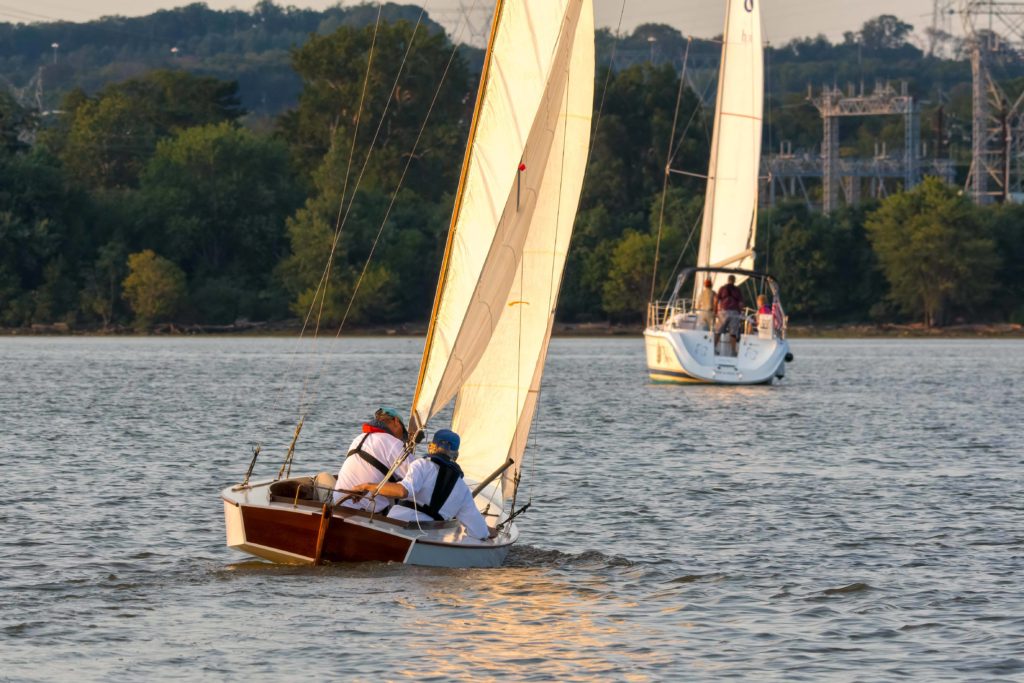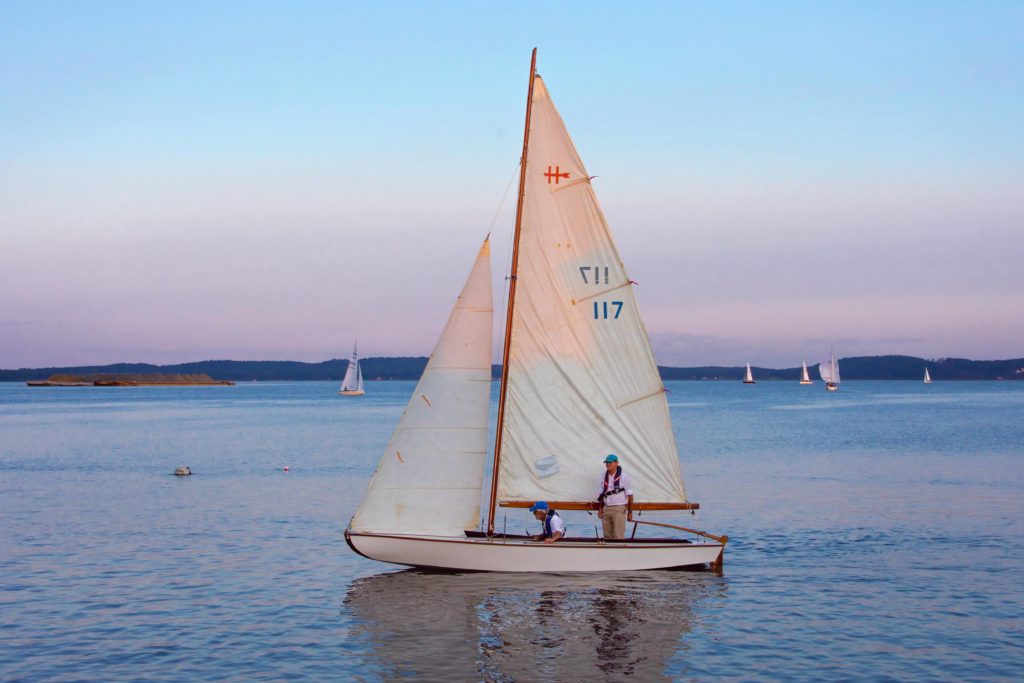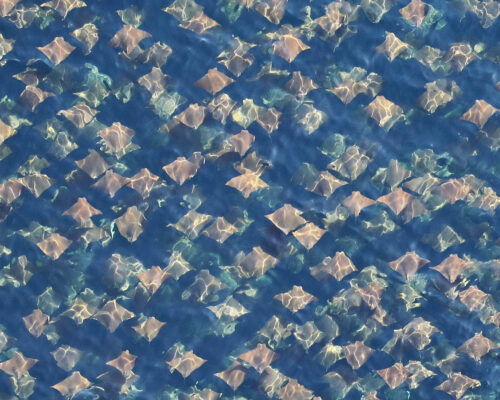Sailboat racing in the Upper Bay has come a long way.
Drive across any bridge around the Bay on a clear afternoon and you’ll see groups of sails dotting the water, racing from marker to marker in picturesque clusters of white on blue. Sailboat racing is ubiquitous around the Bay from spring through late fall, but it wasn’t always that way. A current project at the Havre de Grace Maritime Museum, done in coordination with Havre de Grace Yacht Club, sheds light on the early days of small-boat racing in the Upper Bay, following its development from a sport for the wealthy to an everyday enjoyment accessible to the middle class following World World II. And they even have the boat to illustrate it.
Sailboat racing has been around as long as there have been boats, says Al Caffo, avid history buff and former commodore of the Havre de Grace Yacht Club, when I met him one summer afternoon at the HdG Maritime Museum. “It’s like that old joke: What do you call two boats on the same tack? A race.”
According to Caffo and the museum’s Executive Director Juliette Moore, the nation’s interest in yacht racing really ignited in 1851, when a trio of New York businessmen sailed the schooner America across the Atlantic to England to participate in a race during the World’s Fair. They won the trophy, and that regatta, now known as the America’s Cup, remains the world’s oldest international sporting event. (The modern Olympics didn’t start until 1896.)
Buzz over the race led to the development of yachting clubs all along the East Coast and eventually around the Bay. With its location at the confluence of the Bay and the Susquehanna River, Havre de Grace was an ideal location for one, and the HdG Yacht Club was founded in 1907, with the chief aims of “social, boating, outing and camping.”
Like many clubs around the region, it started off with high hopes but its resources dwindled with the onset of World War I. “Wars tend to end yacht clubs,” said Caffo, “and then they restart again.” And so it went with the HdG Yacht Club, whose initial capital of $1,000 had dwindled to $185 by 1913. The club was loosely reformed in 1927 and formally reincorporated in 1930 with the goal of creating an annual regatta.
At the time, regattas focused on powerboating—typically on daredevil machines with outboard engines that were all about speed. The yacht club’s first race took place on June 14, 1930. A program from a weekend regatta later that summer, on display at the museum, lists a series of powerboat races, along with sculling, rowing, and even swimming races for men and women, but nary a sailboat race. Along with cash prizes and silver trophy cups, gifts were donated from local businesses, including a stopwatch from Pitcock Bros. Hardware, a fountain pen desk set from Green’s Pharmacy, and no fewer than four silver cup cocktail shakers, from the Democratic Ledger, the local Kiwanis Club, Hecht’s Hardware, and Susquehanna Hose Co.
The regatta was a quick success, likely helped along by the city’s reputation as one of the East Coast’s premier horse-racing destinations. The Havre de Grace Racetrack, known as The Graw, ran from 1912 to 1950, drawing viewers from Washington D.C., Baltimore, Philadelphia, and New York to see winning races by Man o’ War, War Admiral, and Seabiscuit, among other thoroughbreds. “Sporting culture at the time was a great social event, from horse racing to regattas,” says Moore.
By 1933, Motor Boating Magazine declared HdG Yacht Club’s regatta to be the largest held in the east, says Caffo. The program for the 7th Annual Regatta in 1936 lists 32 separate powerboat races, with multiple classes and distances, along with a few sailboat races almost as an afterthought. “The course maps for the sail races were not what we would refer to as elegant,” says Caffo, and did not factor in wind speed or direction.

This isn’t to say that boats weren’t racing under sail power in other parts of the Bay. Log canoe sailboat races have been documented since the late 1800s around St. Michaels. But it would take another world event to bring on the popularity of small-boat racing as we know it today. In the wake of World War II, returning servicemen created a new middle class, which led to a major increase in affordable housing, household appliances, automobiles, and yes, sailboats.
In Havre de Grace, Bob McVey was of these returnees. He grew up sailing the upper Bay, joined the Merchant Marine, and then enlisted in the Army at the onset of World War II. Upon returning safely home, he was eager to get back on the water again. So along with two fellow sailors, Marshall Palmer and Steiner Pierce, he invested in a used Hampton One Design (HOD) sailboat.
This classic Chesapeake sailing boat was designed in Hampton, Va., in 1934 by local boatbuilder Vincent Serio. According to the Hampton History Museum, the Hampton Yacht Club wanted to start a one-class boat sailing competition. They chose Serio to design a small sailboat that could be used in regattas and races. One of the key elements was a centerboard, rather than a keel, so the boat could maneuver through the shallow waters of the lower Bay. Equally key was the generous sail size, to take advantage of light winds in the Chesapeake summers. Best of all was the price: Designed as an everyman’s boat, and later available as a kit, a new one retailed for $324.
McVey likely bought his for considerably less, due it its condition; it was said to have been sunk in the water, a deteriorating hull full of sand, when he found it in Chesapeake City. He brought it home and set to work restoring it, naming it Ringer. Despite its humble start, McVey and Ringer became quite the team, and in 1952 they raced to victory in the Admiral Byrd Cup in Cambridge. He continued to be a prolific racer and yacht club supporter until his passing in 1994. His passion and memory is celebrated annually with the HdG Yacht Club’s Bob McVey Memorial Race, the final club race of the season.
But his legacy encompasses more than the race. Fast forward to 2019, when the all-volunteer boat crew at the nearby Havre de Grace Maritime Museum had recently constructed a wooden Opti that was then donated to the local youth sailing program. For their next project, what if they could find and restore an HOD similar to Ringer, the sailboat that set Bob McVey on his racing career?
Under Caffo’s unofficial guidance, the team set to work. HODs are still an active class, with an estimated 700+ boats still racing (though they switched from wood to fiberglass in 1961). To learn more, the team headed to the Hampton History Museum, which had an exhibit on HODs. The exhibit included a refurbished, fully rigged 1947 HOD on display in the lobby, along with tools and artifacts from Serio’s original workshop. During the visit, they met with curator Allen Holiman and shared their hope of restoring an HOD as it would have been when McVey started racing in 1948. Holiman knew people who had wooden HODs they might be willing to donate. David Wingfield had inherited a 1938 HOD from his father, Charlie: Hull 117, built by Serio himself. The hull was rotted in parts, from being stored outdoors, and the original fittings had been replaced by modern ones. Its mast, boom, and rigging had been removed and were used to construct the boat on display in the Hampton museum’s lobby. Wingfield agreed to donate the hull and his brother Ben, who had built an HOD of his own, donated a collection of related blueprints to help with the rebuild.
Holiman also connected them with Mike Evans, who added his circa 1940s HOD to the effort. This boat still had its wooden mast, boom, whisker pole, and bronze fittings. By combining elements from the two boats, they would be able to create a convincing replica of what McVey would have sailed in 1948.
The restoration work was done on the lower floor of the Havre de Grace Maritime Museum, much of it done during the pandemic. Following the faded blueprints and whatever images they could find, they cleaned and patched the hull, painted the deck and topsides, stripped and varnished the mahogany planking, fabricated and attached the mahogany coaming and gunwales, and varnished the king plank, decking, and centerboard. They removed the modern fittings and replaced them with Evan’s bronze originals, fabricating any missing details onsite from bronze and wood. “We learned a lot from YouTube,” says Caffo.
After a year’s delay due to the pandemic, the boat made her public debut in the 2021 Bob McVey Memorial Race, the season ender held on September 10 at Havre de Grace Yacht Cub. For the occasion, the club agreed to have a fourth start, just for the HOD class. “If we’re able to sail around the course, we’ll be able to declare ourselves the winner,” said Caffo the week before they put their project in the water. “But we do have to complete the course, it’s not a slam dunk.” Turns out, the boat performed beautifully on the water, and the win was well earned.
Going forward, Hull 117 will be on display in the boat shop at the museum, and then hopefully taken out each season to represent those early regattas. The whole project is a fitting testament to sailboat racers, then and now. In the words of Bob McVey, “The motivating force that defines the sport of sailing is the satisfaction of finding what your measure of ability is.”
.



